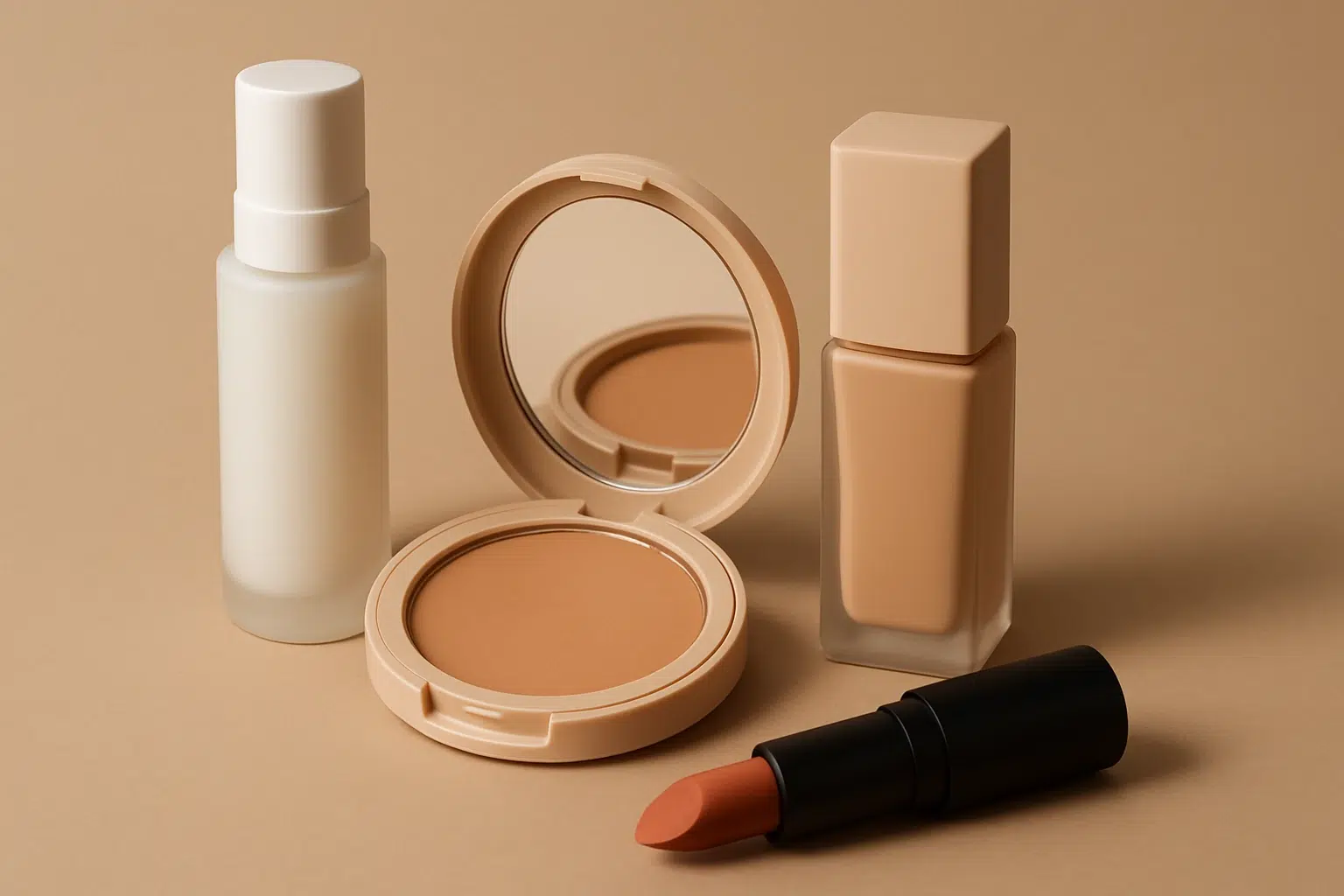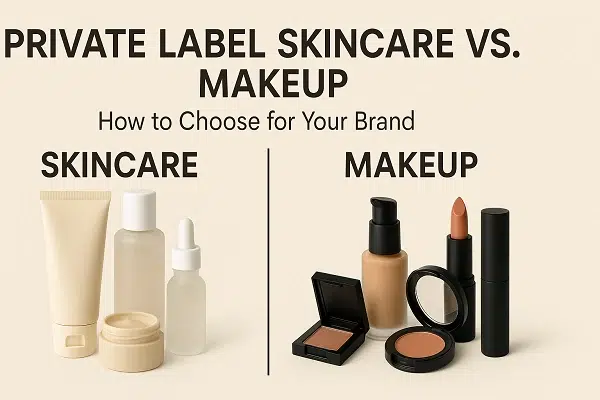Lip gloss is a staple in most makeup bags and provides us with a glossy, shiny boost of color. Although we may assume lip gloss is simply made of pigments and oils, the truth is that the ingredient list can often be quite lengthy.
Table of Contents
To help you understand what you’re putting on your lips, we’ve outlined some of the most common lip gloss ingredients and how they work. Keep reading to learn more about your go-to product.
What Are the Main Ingredients of Lip Gloss?
Below you’ll find a list of the most common lip gloss ingredients and why they’re used in lip gloss formulas for different reasons.
Not every lip balm is built the same and some will contain more of one ingredient and less of another, but the benefit of private labeling your own cosmetics line is that it often gives you the freedom of being able to customize your own formula to meet your own needs.
Emollients
Also known as oils, emollients are the key ingredients in lip gloss that give it the shiny texture that consumers know and love in the product. Emollients can be both natural and synthetic and are often presented as lanolin, castor oil, jojoba oil, or polybutene, and vitamin E—to name a few.
Lip glosses tend to lean more toward waxes than oils to help the texture maintain its thickness and slick look, where lipsticks usually contain more oil than wax to help them feel more velvety on the lips.
In addition to emollients, lip glosses also contain thickeners like other waxes and oils to help them keep their thickness. High-quality lip glosses will have a good balance of both oil and wax to keep from dripping off of the lips or appearing smeared like lipstick might. Again, these ingredients can be either natural or synthetic, depending on the brand or formula.
Coloring Agents
Also known as pigments, these ingredients are added to lip gloss to give them their color—if there is a color, at least. Most lip glosses use dyes or fruit extracts to give them a certain shade and color tint. Natural products are more likely to use fruit extracts but don’t be surprised if most companies use dyes in order to get the right shade of neutral pink.
In glittery glosses, most companies will use an ingredient called Mica or Iron Oxide to create the glittery look. As minerals, these ingredients will help give lip gloss its shiny, glittery texture.
The ingredient isn’t specific to lip glosses as it’s used in many cosmetics, but any ingredient you find in lip gloss has to be approved by the FDA before it can be added to something that is ingested or put directly on the skin.
Control Agents
Just like in your food, your cosmetics need ingredients that help them maintain their structure over time. If you have ever noticed that beauty products (ahem, nail polish) tend to lose their color, separate, or change texture over a long period of time you can thank the control agents that are in the product. These ingredients range from things like preservatives to antioxidants and pH adjusters to help keep them from going bad before their expiration date.
Most control agents in lip glosses don’t differ much from the ones you’d find in other beauty products, but they can range from natural to synthetic ingredients depending on the brand.
Most natural products will avoid using preservatives like parabens because the ingredients are sometimes controversial. Studies have shown that the ingredient can sometimes mimic estrogen levels in the body, which could lead to hormonal imbalances, but there is not enough evidence to support that the ingredients are directly harmful to the body.
While this may be good for marketing purposes, it also makes the products more susceptible to expiring sooner, meaning that consumers may likely notice changes to the formula over time and the risk of having to throw away unsold products after the expiration date. So keep this in mind when developing your formula.
Fragrances and Sweeteners
Because lip glosses go on the lips, it isn’t uncommon for brands to add fragrances and sweeteners to the product to give it a flavor. Like the other ingredients common to lip gloss, these fragrances and flavors can be synthetic or naturally derived (such as from fruit or plant extracts).
Once again, though, even synthetic flavors have to be approved by the Food and Drug Administration to be sold in a product that gets ingested or put directly on the skin.
Lip Gloss Ingredients You Should Avoid
Glossy lips are a timeless beauty statement. But to keep them healthy and free of potentially harmful ingredients, it’s important to know what lip gloss ingredients you should avoid. From potentially toxic parabens to synthetic antioxidants and bee venom, here are some of the ingredients that can be hazardous to your health and how to find natural lip gloss that is free of them.
Parabens?
Parabens are a group of chemicals commonly used as preservatives in cosmetic products such as lip gloss, lotion, and shampoo.
While these chemicals are meant to keep the product from spoiling, they can also have an adverse effect on your health. Parabens have been linked to hormone disruption, which can lead to reproductive issues, and have been found in breast cancer tissue. For this reason, it is best to avoid products with parabens in them.
Natural preservatives such as grapeseed extract, rosemary extract, vitamins C and E, and even honey can be used in place of paraben-containing preservatives. These natural alternatives are free of harsh chemicals and are much better for your health.
Synthetic Antioxidants?
Synthetic antioxidants are chemicals used in cosmetic products to help prevent oxidation and breakdown of the product’s ingredients. Common synthetic antioxidants used in lip glosses include BHA (Butylated Hydroxyanisole), BHT (Butylated Hydroxytoluene), and propylene glycol.
These chemicals have been linked to skin irritation, hormone disruption, and even cancer when exposed to high concentrations over time. As such, avoiding lip glosses with synthetic antioxidants listed in the ingredients is best.
Natural antioxidants from plants such as vitamin E oil, rosemary extract, green tea extract, and chamomile extract are all good alternatives for synthetic antioxidants in lip glosses.
They have anti-aging properties and offer anti-oxidation protection without the potentially harmful side effects associated with synthetic antioxidants.
Bee Venom?
Bee venom is a natural ingredient derived from bees often used in cosmetics for its purported skin-beneficial qualities. It is believed to stimulate collagen production and improve overall skin tone, leaving you with plump, hydrated lips after applying lip gloss containing bee venom.
However, it is important to note that bee venom can cause severe allergic reactions in some individuals, so it is best avoided if you have a known allergy or sensitivity to bee stings.
Fortunately, many natural alternatives to bee venom, such as shea butter, honey, cocoa butter, and sea buckthorn oil, can nourish your lips and give you a glossy finish without exposing you to the potential risk associated with bee venom allergies.
Phthalates?
Phthalates are used as plasticizers in many cosmetic products, such as lip glosses. While these chemicals make the product’s texture smoother and more pliable in contact with skin, they can also leach into the bloodstream through repeated or prolonged use of the product. Studies have linked phthalates to hormone disruption and reproductive health issues, so it’s important to avoid products with phthalates listed in the ingredients.
Many natural plant oils such as olive oil, almond oil, jojoba wax ester, and coconut oil can be used instead of phthalates in lip glosses to achieve a smooth texture while avoiding exposure to potential toxins.
How Can I Be Sure I’m Not Buying Lip Gloss with Unsafe Ingredients?
The best way to be sure that you’re avoiding any potentially hazardous ingredients is by reading through the product label before purchasing any lip gloss product.
Be sure to look for natural preservatives like grapeseed extract or vitamin E instead of parabens; natural antioxidants like green tea extract or rosemary extract instead of synthetic ones; natural moisturizing ingredients like shea butter or coconut oil instead of bee venom; and natural oils like almond oil or jojoba wax ester instead of phthalates.
After eliminating any products with these ingredients listed, you’ll be left with safe options for getting glossy lips without risking your health!
How to Tell If Lip Gloss Is Expired
Lip gloss typically has a shelf life of two to three years, but it can go bad sooner if it’s exposed to extreme temperatures or is not properly sealed. If your lip gloss has been exposed to either of these things, it is best to discard it.
If you are unsure of how old the lip gloss is, here are some signs that your lip gloss has expired:
- The color or consistency has changed. Lip gloss that has gone bad will often lose its original color and become discolored or change in consistency. It may also feel thicker or stickier than normal.
- There is an unpleasant smell. An expired lip gloss will often have a funky smell that can be off-putting. It may also have a sour or musty smell.
- The packaging is damaged. If the container for your lip gloss is cracked or leaking, it’s probably time to toss it out. This is because bacteria can enter the container and cause the product to spoil more quickly than normal.
If you notice any of these signs, it’s best to throw out your lip gloss and buy a new one.
Are Lip Gloss Ingredients Toxic?
The ingredients in lip gloss can vary greatly depending on the brand and type of lip gloss. Some lip glosses can contain toxic chemicals, such as phthalates, parabens, lead, and heavy metals.
However, many natural and organic lip glosses are available that are made with non-toxic ingredients. To choose the safest option, read product labels carefully and look for natural or organic alternatives.
Can Inhalation of Lip Gloss Harm You?
Inhalation of lip gloss can be hazardous to your health due to the possible toxins, chemicals, and fragrances present in the product. Additionally, many lip glosses contain small particles which may irritate the lungs when inhaled.
Short-term inhalation of lip gloss could cause problems such as coughing, throat irritation, and difficulty breathing. Long-term inhalation of these products may lead to more serious health issues such as respiratory diseases. It is best to avoid inhaling any type of product in order to ensure optimal health and safety.
Conclusion
Lip gloss isn’t just for those seeking glossy pout or plumping effects. Lip gloss can add color, hydrate, and protect your lips from day-to-day wear and tear.
With so many types of lip gloss, ingredients, and potential irritants, it’s important to choose the right product that best suits your needs. When in doubt, research what ingredients to avoid and always patch test before applying to your lips.
No matter your preference, a good lip gloss provides more than just beauty – it can provide protection, hydration, and glamour.







